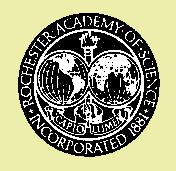Close this article
PROCEEDINGS OF THE ROCHESTER ACADEMY OF SCIENCE
VOL. 2, PP. 171-173
Read to the Academy on December 12, 1892
Preliminary Note of a New Meteorite From Japan
By Professor Henry A. Ward

Rochester, N.Y.
Published by the Society
1893
PRELIMINARY NOTICE OF A NEW METEORITE FROMJAPAN,
By Professor Henry A. Ward. Several months ago a friend, Mr. Alan Owston, who had been traveling in the interior of the main island of Japan, told me that he had seen what he thought to be a stone meteorite in a temple of Iwate. As the result of considerable correspondence this specimen has been sent to me, reaching me early in December. It was accompanied by a letter in Japanese language of which the following is a translation : "This meteorite which I send you herewith fell about forty years ago, viz: in the 3d year of Ka-yei, at dawn on the 4th day of the 5th month, (I3th June, 1850). It fell obliquely front the W.N.W. with a great sound like thunder, at the village of Kesen in the district of Kesen in this Prefecture. It entered the ground five feet, and remained hot for two days. The original size was said to be about equal to 2 1/2 sho of rice. This would be about 1 1/2 cubic feet. There were ten or more pieces of it which have been distributed about in various places.
(Signed) SATO KENJI, Of Nota village, Iwate Prefecture."
The specimen which I have received is 6 1/16 ounces in weight. Its shape is an irregular triangle about 6 1/2 inches in its greatest (vertical) diameter, and about 5 inches thick (see figure). Two long patches an inch wide on either side of the mass are covered with crust; the rest is
![[Line drawing of the meteorite]](KESEN.JPG)
broken surface, showing inner structure. The crust has the usual characteristic pittings. very clearly indented, yet shallow. It is of a dull blackish brown color, with a pebbled or grained appearance. Close examination shows numerous shining metallic points,apparently of iron,with reddish stains, doubtless due to the oxidation of these. This surface shows clear signs of fusion, but there is no flow of the melted part, which might give clue to the direction of flight of the mass. The interior shows no signs of arrangement either in planes or concentric. There are several short fine fissures or fractures from one and a half to two inches in length, some of which reach to the lower side of the surface. They are not parallel, and they were doubtless caused by the shock of reaching the earth. One inner face however seems a little smoothed, as if prior to the breaking off of the contiguous piece there had been a sliding of surfaces. This stone is eminently chondritic. There is a fine-grained paste, and through it are distributed little rounded grains. Both the matrix and the grains are of the same material,--the minerals olivene and enstatite. This is all that is visible to the naked eye. But an ordinary low power lens shows many bright metallic points. Also glossy, waxy pimples of red color, perhaps an effusion of chloride of iron. Some larger blotches of iron rust occur here and there. In determining the metallic portion of the meteorite (whith has been done by Mr. John M. Davison of the Reynolds Laboratory of the University of Rochester), pieces of the mass were finely crushed and the metal separated by the magnet, washed in alcohol and dried rapidly. Its weight having been taken, it was dissolved in nitric acid, and a little insoluble stony matter was separated, weighed and deducted from it. A mean of two determinations made in this way Save the metallic proportion about 16 per cent. of the whole mass. This is an unusual per cent. of metal,-- much more than in the Waconda, which stone resembles in some respects the Kesen,-- which we now name this new meteorite from Japan.We are expecting to soon receive some other pieces, which may give new facts; and also a fuller examination of the mineral constituents -- metallic and non-metallic -- will be made ere long. Professor Ward formally christened the meteorite the ''Kesen Meteorite," and gave a short description of the peculiar features of meteorites, particularly the plasmagraphs or mould marks, illustrated by the specimen before the Academy.
A general discussion followed, which was participated in by many of those present.